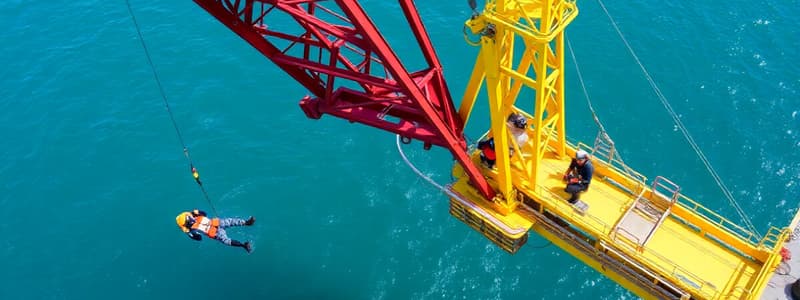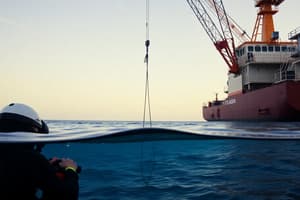Podcast
Questions and Answers
Which of the following factors contributed to the crane hook striking the diver's helmet during the subsea spool tie-in operation?
Which of the following factors contributed to the crane hook striking the diver's helmet during the subsea spool tie-in operation?
- Inadequate length of the crane pennant or stinger combined with poor visibility. (correct)
- The diver's failure to follow the correct procedures for disconnecting rigging.
- The crane operator's lack of experience in subsea lifting operations.
- The failure to conduct a Job Hazard Analysis (JHA) prior to the operation.
What action taken after the incident demonstrates a proactive approach to preventing recurrence, according to the document?
What action taken after the incident demonstrates a proactive approach to preventing recurrence, according to the document?
- The prompt assistance provided by Diver 2 to Diver 1 after the incident.
- The update of project procedures to specify minimum pennant lengths and pre-operation inspections. (correct)
- The immediate return of the divers to the dive bell.
- The inspection of the damaged helmet to assess its durability.
In subsea operations with poor visibility, what additional measures could improve the tracking and positioning of critical equipment such as crane hooks?
In subsea operations with poor visibility, what additional measures could improve the tracking and positioning of critical equipment such as crane hooks?
- Decreasing the frequency of pre-operation inspections to save time.
- Implementing alternative methods such as additional locating beacons, underwater cameras, or sonar. (correct)
- Relying solely on verbal communication between the dive supervisor and the crane operator.
- Using longer crane pennants to increase the distance between divers and the hook regardless of the specific task.
What assumption, if unchallenged, led to the crane hook striking the diver's helmet?
What assumption, if unchallenged, led to the crane hook striking the diver's helmet?
Besides adequate length of crane pennant, what other procedural reinforcement could prevent similar incidents?
Besides adequate length of crane pennant, what other procedural reinforcement could prevent similar incidents?
Flashcards
Incident Summary
Incident Summary
During subsea spool tie-in operations, a crane hook unexpectedly struck a diver's helmet, damaging it beyond repair, but the diver was unharmed.
Causes of the Incident
Causes of the Incident
Inadequate length of crane pennant and poor visibility hindered the ability to observe the crane hook's position, leading to the incident.
Lessons and Actions
Lessons and Actions
Ensure adequate distance between divers and the crane hook, use visibility aids, reinforce communications, and challenge assumptions to enhance safety.
Reinforce Communications
Reinforce Communications
Signup and view all the flashcards
Enhanced Visibility
Enhanced Visibility
Signup and view all the flashcards
Study Notes
- During subsea spool tie-in ops, a crane hook unexpectedly struck a diver's helmet
- The incident occurred on March 6, 2025
Incident Details
- Divers were working on the seabed with poor visibility when it happened
- After landing the pipe handling frame (PHF), the Diving Supervisor told the crane operator to lower the crane hook to disconnect rigging
- The crane operator reported 'no weight' on the crane wire, leading the Diving Supervisor to assume the hook was on the seabed
Incident specifics
- While the diver was disconnecting rigging under the PHF, the crane hook unexpectedly struck the diver's helmet
- The diver was unharmed and they returned to the dive bell
- The diver's reclaim helmet was damaged beyond repair at the side block
- The helmet's integrity was upheld, and the diver was unharmed
Positive Outcomes
- Diver 2 helped Diver 1 and ensured there were no injuries
- Both divers returned to bell safely
- Divers fitted beacons and the crane block enabled accurate tracking
- Procedures, lifting plans, and Job Hazard Analysis (JHA's) were followed
- Protective equipment absorbed the impact, which kept the diver uninjured
What Went Wrong
- The crane hook rested on the top beam of the PHF, which caused a 'no weight' reading, which led the crane operator to assume the hook was on the seabed
- The hook slipped off the beam and struck the side of the diver's helmet
Causation
- Insufficient length of crane pennant/stinger did not provide distance between the divers and crane hook
- Poor visibility hindered the ability to accurately observe the position of the crane hook
Lessons and Actions
- Ensure the length of the crane is sufficient to maintain a safe distance between the divers and crane hook during subsea operations, even during limited visibility conditions
- Use visibility aids and monitoring by using alternative methods such as additional beacons, underwater cameras, or sonar to track the position of crane hook
- Improve communication by reinforcing clear communication between the dive supervisor, crane operator, and divers at all times
Preventative steps
- Updated project procedures to specify minimum pennant lengths for different operations
- Conduct pre-operation inspections of all rigging and lifting equipment
- Update the Job Hazard Analysis (JHA) to incorporate lessons learned regarding safe distances, visibility, and communication requirements for subsea lifting operations
Studying That Suits You
Use AI to generate personalized quizzes and flashcards to suit your learning preferences.




